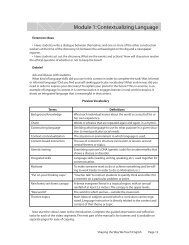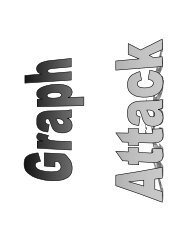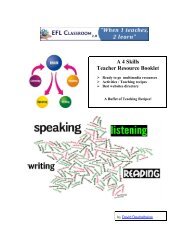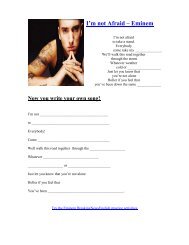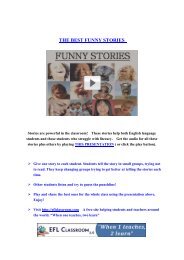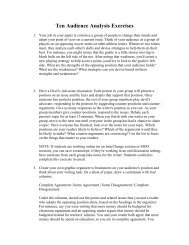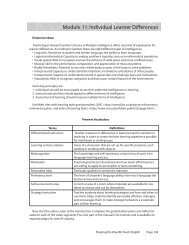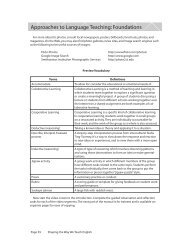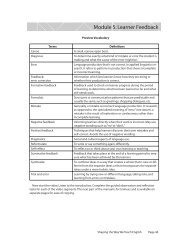Module 7: Learning Strategies - EFL Classroom 2.0
Module 7: Learning Strategies - EFL Classroom 2.0
Module 7: Learning Strategies - EFL Classroom 2.0
You also want an ePaper? Increase the reach of your titles
YUMPU automatically turns print PDFs into web optimized ePapers that Google loves.
Approaches to Language Teaching: Extension<br />
strategy instruction is crucial for them. It has been demonstrated that when struggling students are<br />
taught strategies and are given ample encouragement, feedback, and opportunities to use them,<br />
students improve in their ability to process information, which, in turn, leads to improved learning.<br />
Because not all students will find it easy to imbed strategy use in their learning schema, differentiation<br />
of strategies instruction is required, with some students needing more scaffolding and individualized,<br />
intensive instruction than others.<br />
Why is it important to teach children to be strategic?<br />
The Individuals with Disabilities Education Act (IDEA) of 1997 and the No Child Left Behind (NCLB)<br />
Act of 2001 focus on improved achievement by all students. IDEA mandates that all students access<br />
and progress in the general education curriculum. This includes students with disabilities, English<br />
language learners, and gifted students. NCLB has established performance goals that drive the efforts<br />
of public schools, especially in establishing proficiency in reading / language arts and mathematics<br />
by all students by the year 2013-2014. The outcomes listed below help ensure student progress.<br />
Additionally, when students become strategic, independent learners, they also become literate and<br />
productive lifelong learners.<br />
What happens to students when they become strategic?<br />
The following outcomes can be expected:<br />
• Students trust their minds.<br />
• Students know there’s more than one right way to do things.<br />
• They acknowledge their mistakes and try to rectify them.<br />
• They evaluate their products and behavior.<br />
• Memories are enhanced.<br />
• <strong>Learning</strong> increases.<br />
• Self-esteem increases.<br />
• Students feel a sense of power.<br />
• Students become more responsible.<br />
• Work completion and accuracy improve.<br />
• Students develop and use a personal study process.<br />
• They know how to “try.”<br />
• On-task time increases; students are more “engaged.”<br />
What are the most essential strategies to teach?<br />
This is determined, in large part, by assessing what successful, efficient learners do. It has been<br />
found that they use numerous strategies across subjects and tasks, such as those listed above under<br />
“cognitive strategies”. They know when to use strategies and for what purposes. An attempt to identify<br />
the most essential strategies students should learn is an impossible task; it depends on the needs<br />
of the learner and the requirements of the curriculum. However, student use of the following strategies<br />
often leads to improved student performance (lists are not inclusive):<br />
• Computation and problem-solving: Verbalization, visualization, chunking, making associations,<br />
use of cues.<br />
• Memory: Visualization, verbalization, mnemonics, making associations, chunking, and writing.<br />
These are usually more effective when used in combinations.<br />
• Productivity: Verbalization, self-monitoring, visualization, use of cues.<br />
• Reading accuracy and fluency: Finger pointing or tracking, sounding out unknown words, self-<br />
Page 108<br />
Shaping the Way We Teach English



